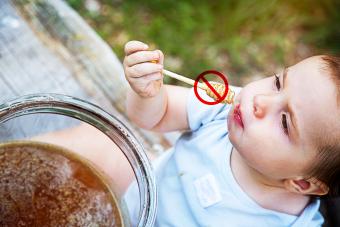
It is not unusual for your newborn baby's skin color to change over the first few months of life. Newborn skin color changes vary from one baby to another depending on ethnic background, baby's age, temperature and even simple things, like whether the baby is crying or not.
It can actually take up to a year for your baby's permanent skin color to develop. This is primarily due to genetics. Your baby's skin pigmentation is controlled by genetics and the various traits that he or she inherits from mom and dad. The baby's skin color can be affected by many different genetic substances. The pigment melanin is the most important genetic substance that will determine your baby's true skin color. Keep in mind, that these inherited genes can ultimately result in a wide variety of skin tones for your baby.
Different Types of Newborn Skin Color Changes
A baby's skin color often changes with the environment and health. In fact, right after a baby is born the color of his skin may appear dark red or purple. However, as the infant breathes his color brightens to a red. This redness should fade during the first 24 hours, but the baby's feet and hands may continue to have a bluish tint for several days. This bluish cast to newborn skin changes as the baby matures and the infant's immature blood circulation changes. However, the rest of the body should not show evidence of this bluish color. If it does, be sure to contact your doctor immediately.
Jaundice or Yellow Skin Tone
When a newborn's skin changes to a yellowish color, this is known as jaundice. If your baby is premature, he is likely to develop jaundice. Actually, over half of all newborns develop jaundice to some extent during the first week of life.
If you think your baby may be jaundiced, gently press the baby's forehead or chest and watch the color return. In some cases, laboratory tests are necessary to assess jaundice which may occur for a number of reasons.
Most often, jaundice is only a temporary condition, but it's important to note that it can also be a sign of a more serious illness. Jaundice occurs as old red blood cells break down and hemoglobin is changed into bilirubin. Bilirubin is then removed by the liver. The build-up of bilirubin in the blood is called hyperbilirubinemia. It is because of bilirubin pigment that yellowing of the baby's skin and tissue occurs. Jaundice goes away as the baby's liver matures.
Types of Jaundice
The various types of jaundice include:
- Physiologic jaundice - Normal response to the newborn's limited capability to expel bilirubin in the first days of life.
- Breast milk jaundice - Around 2 percent of breastfed babies develop jaundice after the first seven days. Others develop breast milk jaundice in the first week because of low-calorie intake or dehydration.
- Jaundice from hemolysis - Jaundice can also be the result of the breakdown of red blood cells due to Rh disease (hemolytic disease) of the newborn because they have too many red blood cells or are bleeding.
- Jaundice related to inadequate liver function - This jaundice may be due to infection or other factors.
Treatment for Jaundice
Because there are varying reasons for the occurrence of jaundice, treatment depends on several factors. Treatment may include phototherapy, a light therapy that is used to help break down the excess bilirubin in the newborn's body. In severe cases, newborns may require hospitalization and possible blood transfusions.
There may be other issues associated with jaundice. These problems can include feeding problems, irritability or listlessness. If you notice any of these symptoms, it's important to contact your doctor immediately.
Blue Skin Tone
Blood circulation may cause a blue cast to a newborn's skin, but this color gives way to healthy red which fades to pink within a day or two. However, if the blue coloring is not limited to the baby's hands and feet, this is a warning something may be wrong.
Sometimes when a baby cries hard his lips, mouth or face might turn a purplish color, but when the crying stops, everything should go back to pink. If it doesn't or if the baby's skin tone holds a bluish tint, this signals a possible problem.
Blue coloring that occurs in infants with a heart defect is called cyanosis. The baby's skin color changes because the heart is not pumping oxygenated blood to the rest of the body, or because a breathing problem exists.
Blue or Purple Spots
One last skin color change worth mentioning is Mongolian spots. These blue or purple-colored splotches appear on the infant's lower back and buttocks. More than 80 percent of babies of African or Asian descent have Mongolian spots, but they can also show up in dark-skinned babies of any race. These spots are the result of a concentration of pigmented cells, but they often disappear in the first four years of life.
Skin Color and the Health of Your Newborn
Every newborn is different, from the shape of her head, size of her body, color of her skin and more. Some differences are temporary and change as your baby adjusts to being in this world. Other things like birthmarks are often permanent. As a parent, it is important to understand your newborn's skin color changes and how it can affect the health of your baby. If you have concerns about your baby's skin color, speak with your healthcare provider to get personalized guidance.







